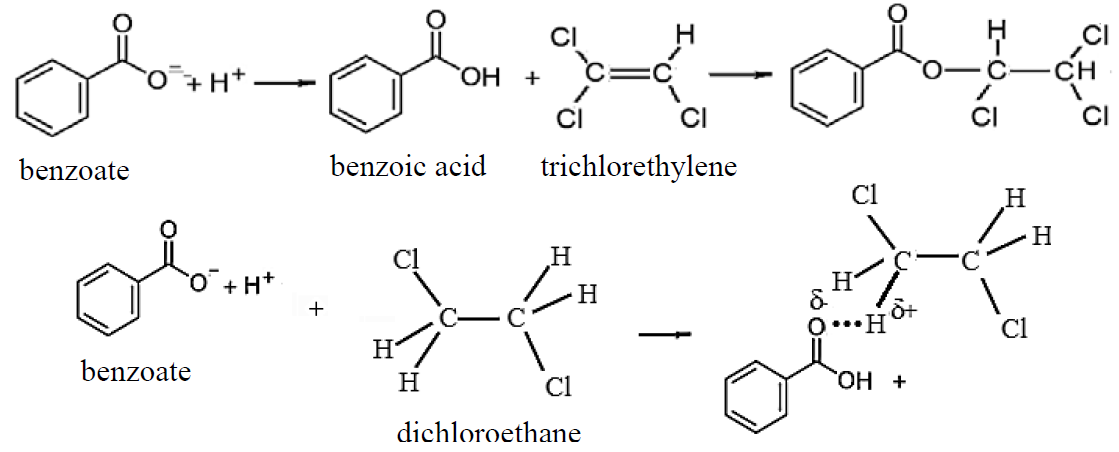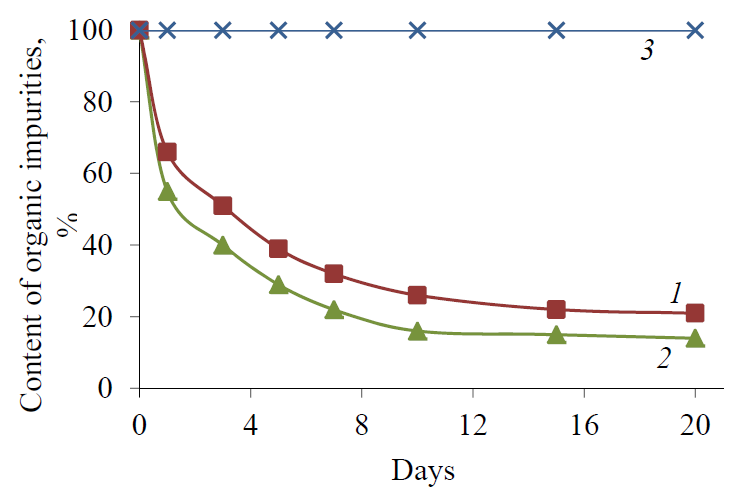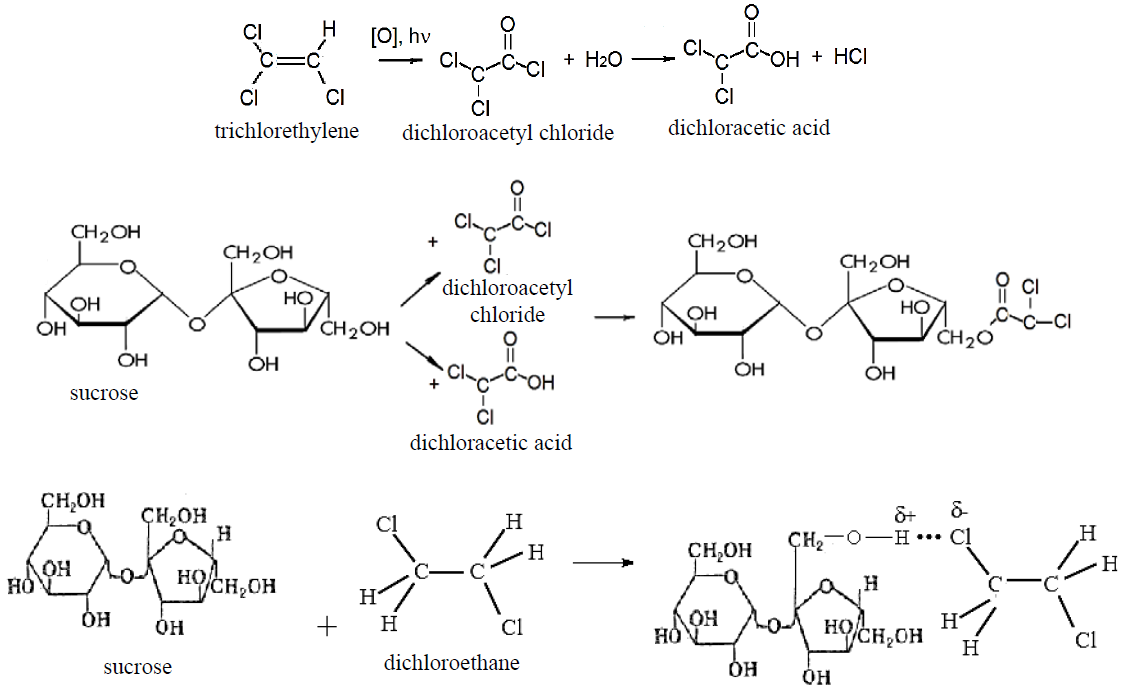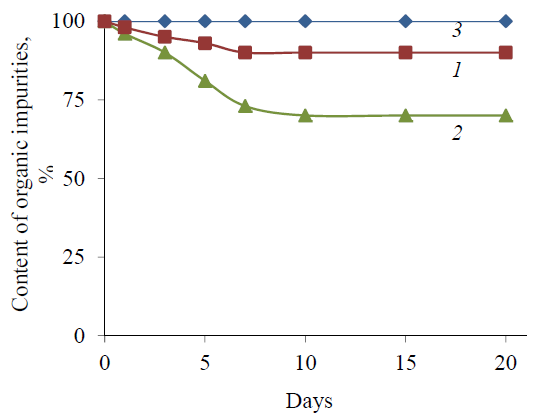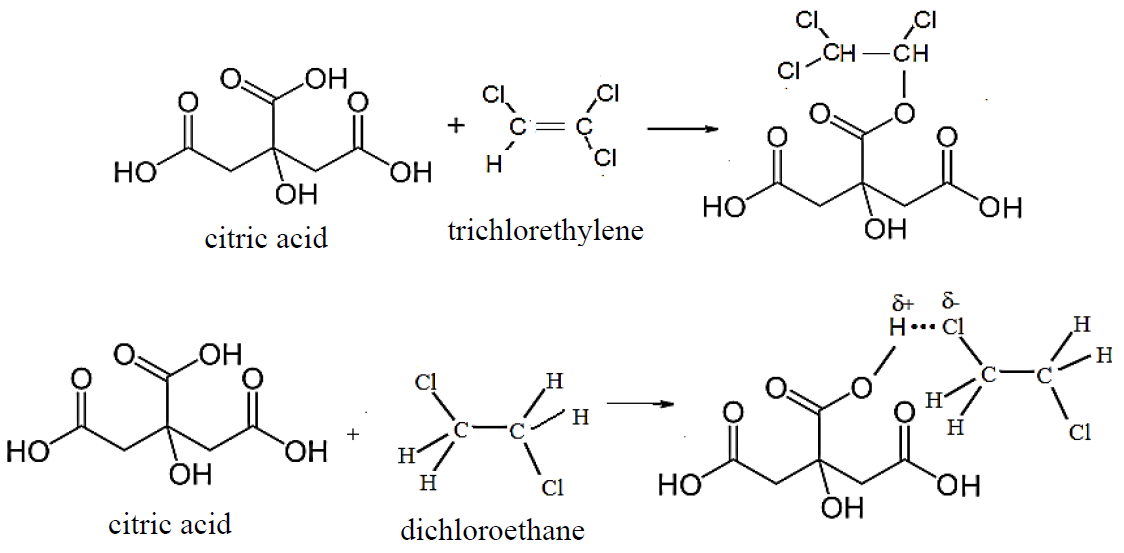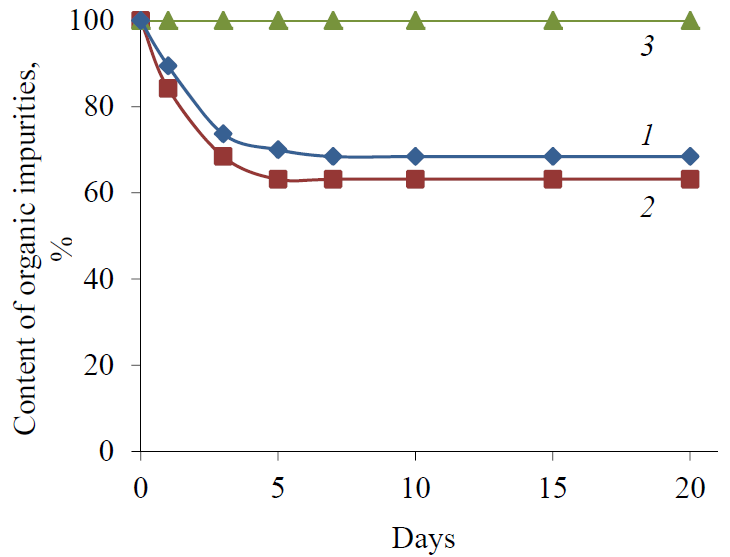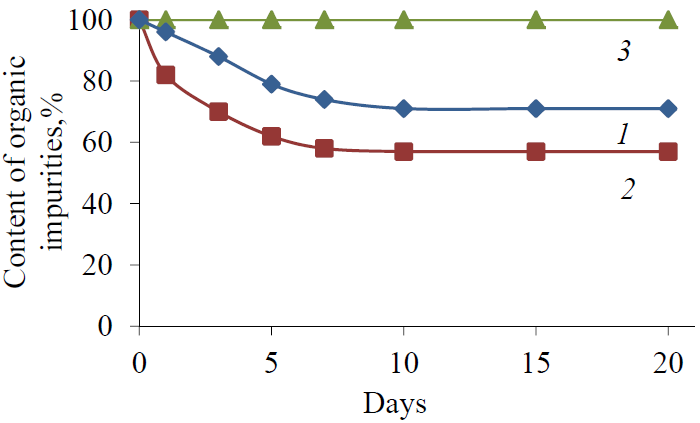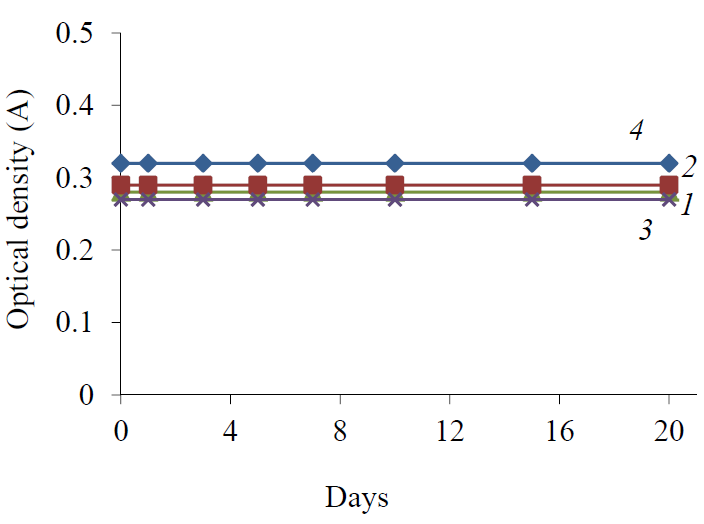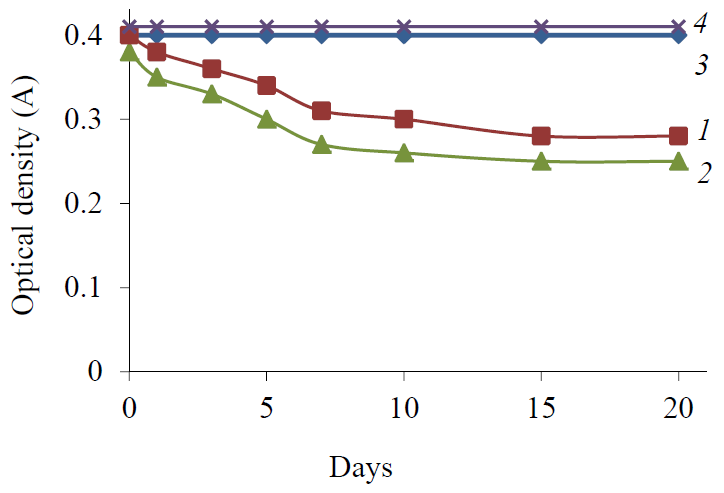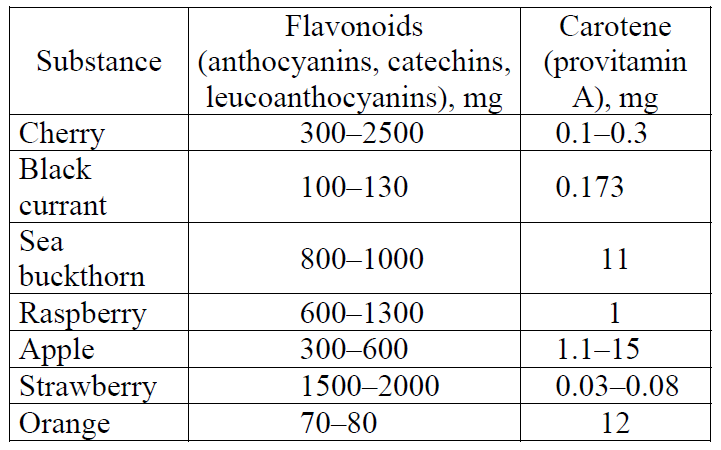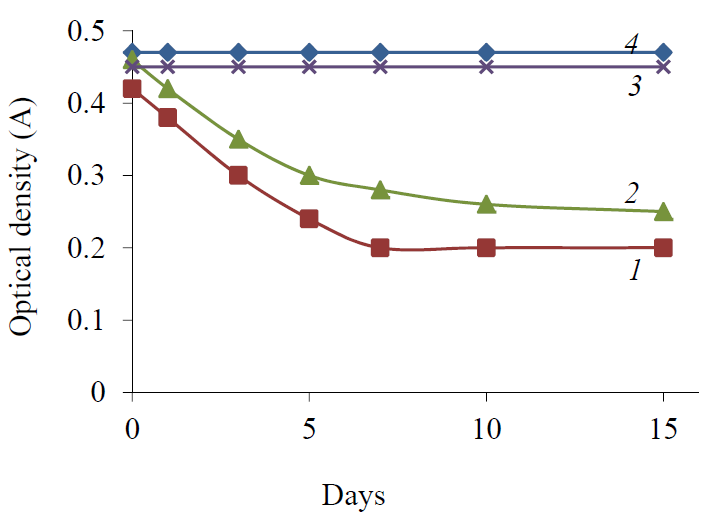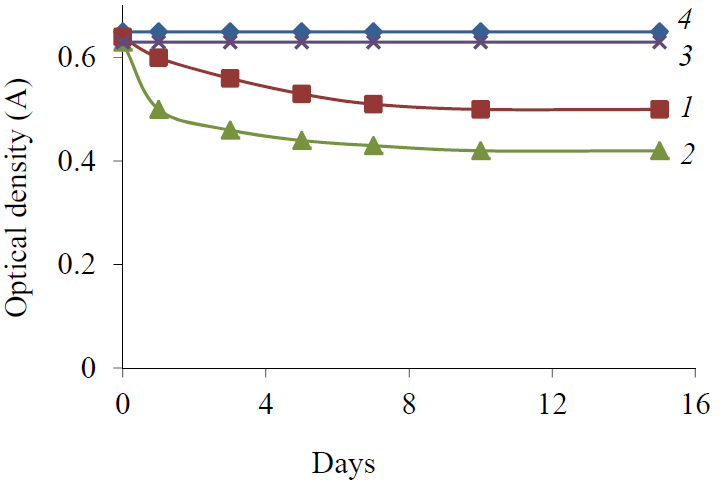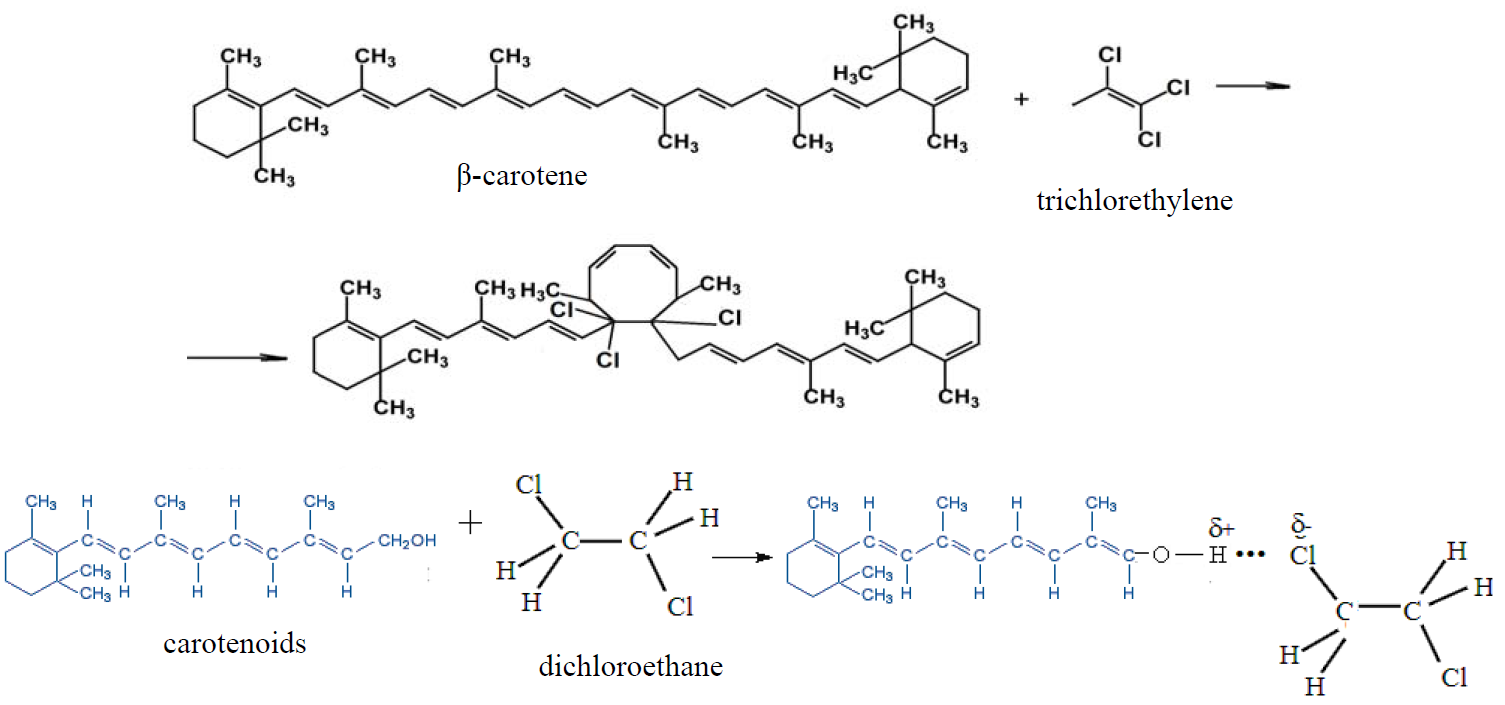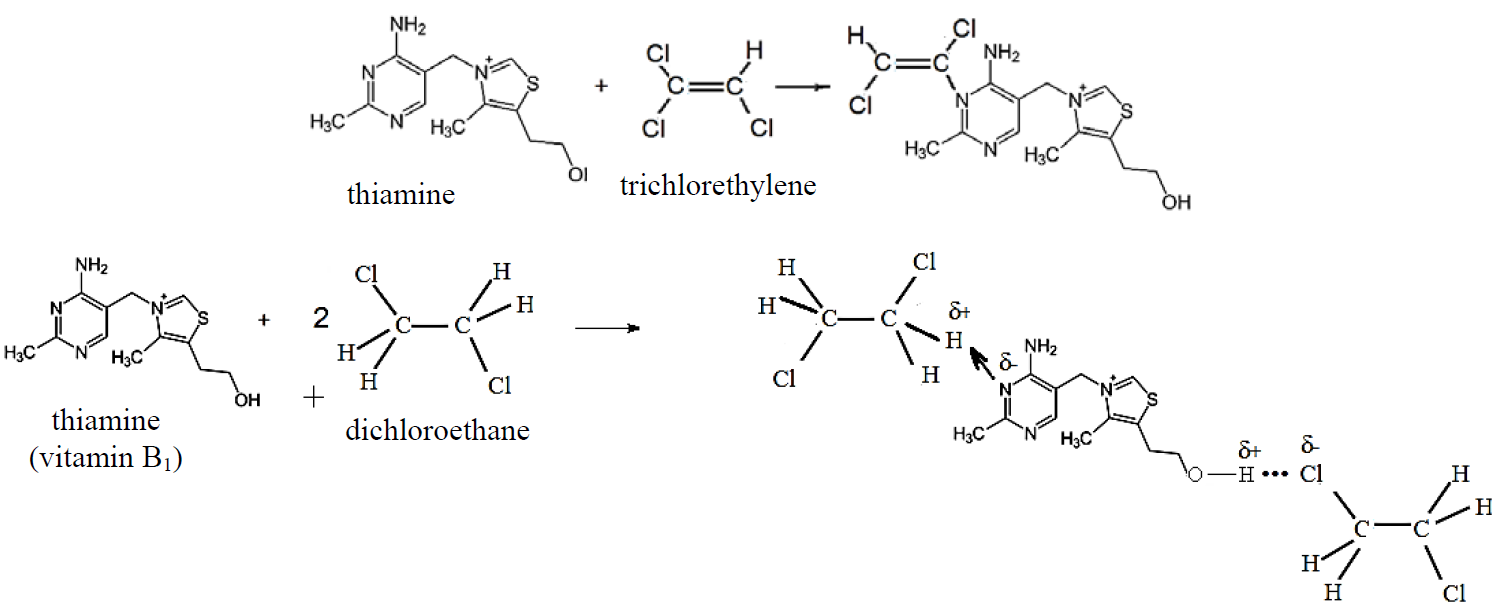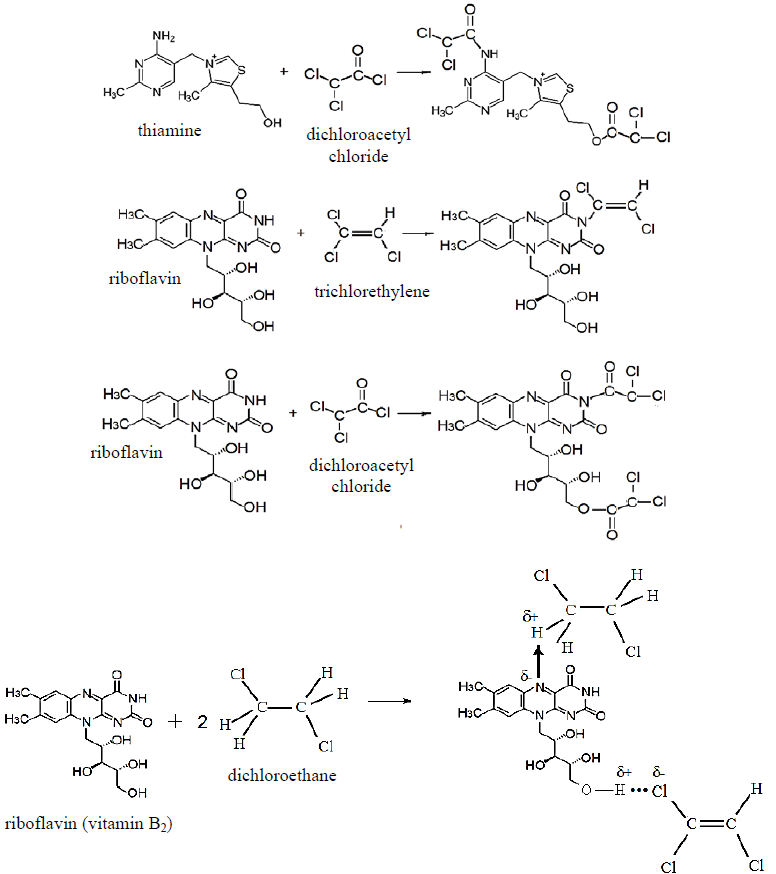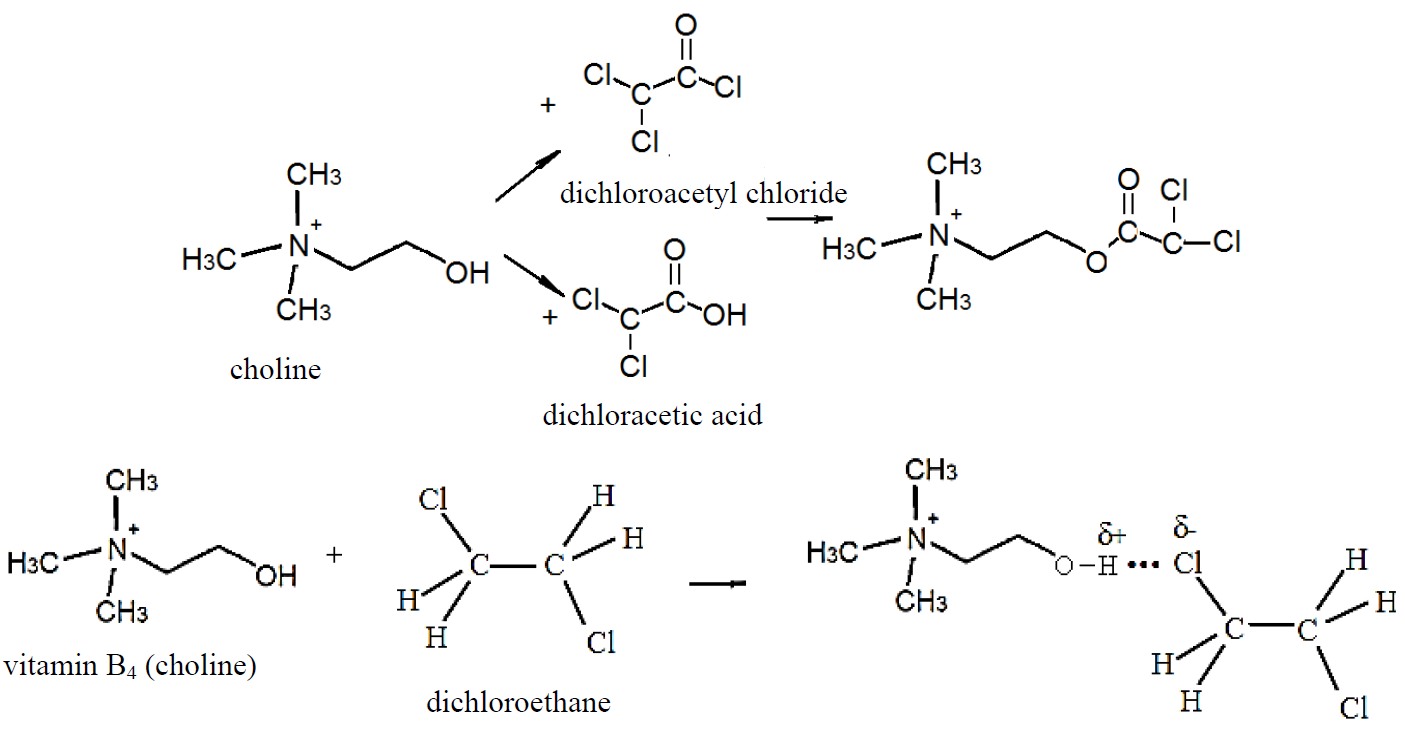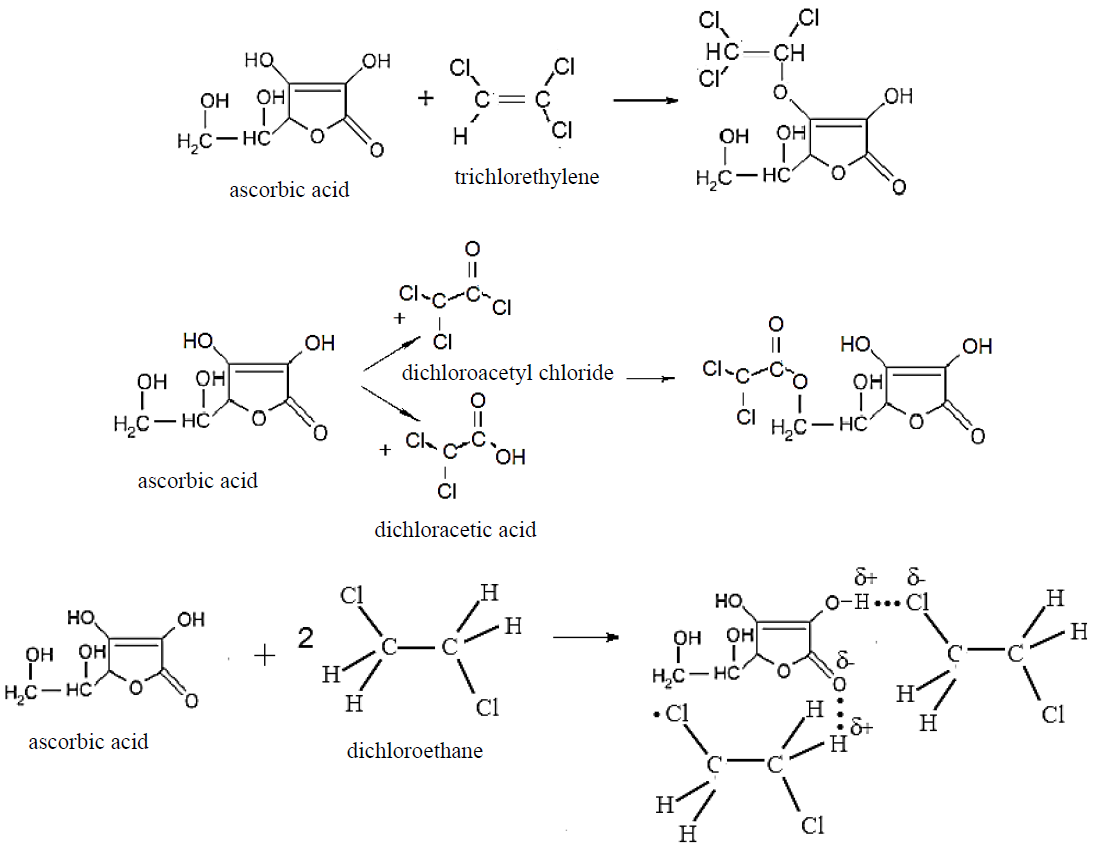Аннотация
Currently, water from the centralized domestic drinking water supply system is mainly used to make non- alcoholic carbonated beverages and nectars. The classical technology does not always provide the purification of water from organic compounds. In addition, during water preparation, at the primary chlorination stage, chlorine-containing organic compounds (chloroform, dichloroethane, trichlorethylene, etc.) are formed due to the interaction of chlorine with natural organic substances. The by-products of natural water treatment by chloragents, in addition to the toxic and carcinogenic effects, can interact with the main components of products reducing their quality. Such water cannot be used for drinking purposes and in food production without the additional post-treatment. The results of the study of the effect of organic impurities present in water (chloroform, trichlorethylene and dichloroethane) on the stability of the components of non-alcoholic carbonated beverages (sodium benzoate, sucrose, citric acid, natural and synthetic dyes and vanillin) and nectars (color stability, vitamins A, C, group B) have been provided. The studies were carried out in the Kemerovo region using gas-liquid chromatography, molecular absorption spectroscopy, refractometry and capillary electrophoresis. The concentration of the main components of non-alcoholic carbonated beverages, nectars and priority contaminants (trichlorethylene and dichloroethane) has been reduced. It has been shown that chloroform does not come into chemical interaction with the components of beverages. The mechanism of interaction of sucrose, citric acid, sodium benzoate, vanillin, vitamins in non-alcoholic carbonated beverages and nectars with trichlorethylene and dichloroethane has been theoretically justified. It has been established that dichloroethane and trichlorethylene have a significant effect on the resistance of the main components of non-alcoholic carbonated beverages, with the exception of dyes, and also on the intensity of color and the preservation of vitamins of nectars, reducing the quality characteristics of beverages during production and storage.Ключевые слова
Chloroform, trichlorethylene, dichloroethane, drinking water, carbonated non-alcoholic beverages, nectars, quality indicatorsВВЕДЕНИЕ
Mass consumption products, including beverages, are of great importance among food products. Currently, nectars that are more affordable than juices and non-alcoholic carbonated beverages are becoming more popular with a large part of the population of Russia among non-alcoholic beverages.
In non-alcoholic production, water is used from the centralized domestic drinking water supply system. According to Rospotrebnadzor and our longterm studies it was found that the content of chloroform increases in natural water in the springsummer period [1]. In addition, chloroform, dichloroethane and trichlorethylene are formed as byproducts after the treatment of natural water with chloragents. The classical technology of water treatment does not provide the complete purification of water from organic substances [2]. According to the Department of Natural Resources and Ecology of the Kemerovo Region in Kuzbass in 2011–2016, the proportion of water samples from the centralized water supply distribution network that did not meet hygienic standards for sanitary and chemical indicators was 9.4–13.8% [3].
For deep water purification at the enterprises of beer and alcoholic beverage industries corresponding to the modern level, reverse osmosis plants are mainly used [4]. However, it should be noted that the studies of foreign scientists have found that chloroform, trichlorethylene and dichloroethane are not practically retained even by highly selective reverse osmotic membranes [5, 6].
Chloroform, according to the classification of the International Agency for Research on Cancer (IARC, Lyon, France), which is part of WHO, is assigned to a 2B group, i.e. to the substances possibly carcinogenic to human (potentially dangerous substances). Earlier on [7–11], the effect of chloroform on human health was noted. In recent years, the direct correlation of consumption of chlorinated water with the increased risk of oncological diseases (of rectum, bladder, urinary tract and brain) has been found. Thus, according to the scientists at Columbia University in the United States, those people who consume water that contains halogen-organic compounds have a 44% increase in the risk of gastrointestinal and bladder cancer [12–14].
Trichlorethylene refers to hazard category 1 substances. Back in 2012, WHO recognized the compound as carcinogenic. The latest research suggests that trichlorethylene increases the risk of cancer of the liver, kidneys, esophagus and cervix. Trichlorethylene is the strongest narcotic drug. It differs from other narcotic drugs in the fact that it provides strong analgesia at a small concentration. A relationship has been found between the regular exposure of trichlorethylene to human and the subsequent development of Parkinson's disease. Constant contact with the chemical increases the risk of the disease by 6 times.
Dichloroethane refers to hazard category 2 substances. When intaken, it causes damage to the central nervous system, the liver, kidneys and the cardiac muscle. It has a narcotic, toxic and carcinogenic effect. The pattern of intoxication by dichloroethane is similar to that of intoxication by chloroform [15].
These substances reduce the safety of water. According to the Hygienic Standard HS 2.1.5.2280-07 "Maximum permissible concentration (MPC) of chemicals in water bodies of drinking and cultural and community water use" (Additions and amendments 1 to hygienic standards HS 2.1.5.1315-03), MPC of chloroform in the water of economic-drinking and cultural-domestic water objects is 0.060 mg/dm3, trichlorethylene is 0.005 mg/dm3 and dichloroethane is 0.003 mg/dm3.
In this regard, the studies of the effect of the priority organic contaminants formed in the process of water treatment in the chlorination stage (chloroform, dichloroethane and trichlorethylene) and capable of provoking oncological diseases on the quality of food products are relevant and timely. The study aims at the effect of chloroform, dichloroethane and trichlorethylene on the stability of the main formulation components of beverages during production and storage.
ОБЪЕКТЫ И МЕТОДЫ ИССЛЕДОВАНИЯ
The subjects of the study were the aqueous solutions of the formulation components of beverages (sucrose, vanillin, sodium benzoate, citric acid, dyes and tarragon) and the aqueous solutions with the addition of organic substances (chloroform, dichloroethane, trichlorethylene); mass consumption beverages – nectars from raspberry, strawberry, seabuckthorn berries, black currant, cherry and orange and apple fruits prepared on the water basis without organic impurities and aqueous solutions containing chloroform, trichlorethylene and dichloroethane.
The concentration of sodium benzoate in the samples was 0.1441 mg/dm3, dyes (brilliant blue, brown chocolate, green apple, yellow sunset, tartrazine, carmoisine, Ponso 4R) – 100 mg/kg according to TR TS 029/2012 "Safety requirements for food additives, flavorings and technological aids". The concentration of sucrose was 342.3 mg/kg, citric acid – 5 mg/dm3 according to TR TS 023/2011 "Technical regulations for fruit and vegetable juice products". The concentration of organic contaminants in the studied systems was 10 MPC, which corresponds to the maximum possible increase in the content of contaminants in the water of the domestic drinking water supply system in different seasons of the year [16].
The content of chloroform, trichlorethylene and dichloroethane was determined using a standard method (gas-liquid chromatography) using an electron capture detector, the lower limit of 0.01 μg according to GOST R 31951-2012. The following was performed before measuring: the preparation of solutions, the preparation of a chromatographic column, sampling. The concentrations of the solutions analyzed were determined from a calibration graph. The content of sodium benzoate was determined by molecular absorption spectroscopy with hydroxylamine hydrochloride and hydrogen peroxide in the presence of Cu2+ ions to form a colored nitrosophenol derivative at a wavelength of 364 nm [10]. The content of citric acid was determined using the method of molecular absorption spectroscopy with the formation of a complex compound with ammonium vanadate at a wavelength of 400 nm in accordance with GOST 28467-90. The intensity of the coloring of dyes and nectars in the samples was also determined using the method of molecular absorption spectroscopy at a wavelength of 400–440 nm. The content of sucrose in the samples was determined by refractometry based on the determination of the refractive indices of a number of standard solutions followed by plotting a calibration curve in accordance with GOST 15113.6-77. B and C vitamins in water were determined by capillary electrophoresis using Kapel-105M (Lumex, St. Petersburg) [17, 18]. The analysis was carried out under the following conditions: the total length of a capillary is 60 cm, the effective length (i.e. the length from the entrance to the detector window) is 50 cm, the working voltage applied to the electrodes is 20 kV, the internal diameter of a capillary is 50 μm, the detection is at 200 nm, the temperature is 200°С, the composition of the reaction buffer is 40 cm3 of sodium tetraborate solution (0.05 mol/dm3), 20 cm3 of boric acid solution (0.2 mol/dm3). The aqueous contaminant containing vanillin solutions were observed using the olfactory method.
The changes in all the indicators were observed for 20 days.
РЕЗУЛЬТАТЫ И ИХ ОБСУЖДЕНИЕ
Sodium benzoate. Regardless of the composition and purpose of a drink (general, special), the most commonly used component of most soft drinks is sodium benzoate. Its content and consumption in beverages are strictly controlled by formulations, sanitary regulations and standards and process instructions.
Table 1 presents a decrease in the content of sodium benzoate in the presence of organic substances.
In the presence of chloroform, the concentration of sodium benzoate in water remained unchanged throughout the study period. It has been found that the lowest decrease in the sodium benzoate content in the first days of the study was in the presence of trichlorethylene, and the highest – in the presence of dichloroethane in water. It should be noted that after 10 days of storage the concentration of sodium benzoate decreased in the presence of trichlorethylene by 94.1%, of dichloroethane – by 97.4%. The reduction in the sodium benzoate content, leading to a decrease in the quality of the finished product, is evidently due to its chemical interaction with the priority contaminants contained in water (Fig. 1). Trichlorethylene is characterized by the attachment between the sites of organic acids forming the corresponding organochlorine esters [19]. Dichloroethane interacts with the oxygen of the carboxyl group of benzoic acid forming hydrogen bonds (Fig. 1).
The chemical interaction of organic impurities with sodium benzoate has also been experimentally confirmed by a corresponding decrease in trichlorethylene and chloroethane in water over time (Fig. 2).
Sucrose (C12H22O11) is one of the main components that make up carbonated beverages and nectars. Given the chemical properties of sucrose and the studied organic contaminants contained in water, there is a possibility of their chemical interaction.
Table 2 presents a decrease in the content of sucrose in the presence of organic substances. It has been established that all organic contaminants, except for chloroform, interact with sucrose, while the quality of the finished beverage decreases. Sucrose interacted most violently with dichloroethane, most weakly – with trichlorethylene.
The chemical interaction of organic substances with sucrose has theoretically been confirmed by chemical equations. Trichlorethylene decomposes in the presence of oxygen dissolved in water forming dichloroacetyl chloride, which can be hydrolyzed to dichloroacetic acid in aqueous solutions (Fig. 3) [20].
Both dichloroacetyl chloride and dichloroacetic acid are active compounds capable of entering into esterification and nucleophilic addition reactions [20–21]. When reacting with the compounds containing an alcohol (phenolic) group, the formation of organochlorine compound esters is possible. For dichloroethane, the presence of electronegative chlorine atoms promotes the redistribution of electron density on the atoms of a molecule and, as a consequence, the formation of hydrogen bonds with the hydrogen of the sucrose alcohol group (Fig. 3).
The chemical interaction of organic contaminants has also been experimentally confirmed by their corresponding decrease in the presence of sucrose (Fig. 4) and agrees with the data in Table 2.
Сіtric acid. As an acidity regulator in the production of soft drinks and nectars, citric acid (C6H8O7 · H2O) is most often used, since it has the mildest taste in comparison with other food acids and does not irritate the mucous membranes of the gastrointestinal tract. There is a possibility of the interaction of citric acid with organic components. In this connection, the effect of organic impurities (trichlorethylene, dichloroethane and chloroform) contained in water on the resistance of citric acid used in the production of beverages and nectars, has been studied.
The experimental data indicate that the content of citric acid decreases in the presence of all organic contaminants except chloroform (Table 3). Fig. 5 presents the chemical reactions between citric acid and the priority water contaminants.
The chemical interaction of organic impurities with citric acid has experimentally been confirmed by a corresponding decrease in the content of trichlorethylene and dichloroethane in the presence of citric acid in water over time, shown in Figure 6, and is consistent with the data in Table 3.
It has been found that citric acid, sodium benzoate and sucrose are characterized by a sharp decrease in their content in the first day of the study, then the concentration of formulation components either decreases slowly or remains at the same level. In connection with a significant loss of sodium benzoate (94.1%) and citric acid (31.6%) in the presence of organochlorine compounds, their additional amount is needed to compensate for losses and preserve the quality of beverages. Given that sodium benzoate and citric acid are expensive components, their excess consumption is undesirable.
Vanillin. Vanillin is one the aromatizing agents most often used in the production of beverages. The introduction of a vanilla aromatizer into the formulation makes it possible to improve the organoleptic properties of a drink by giving it an original pleasant harmonious taste and a unique soft vanilla flavor.
Based on the chemical properties of vanillin, we can expect its interaction with organic water contaminants. In this connection, the effect of priority contaminants on the stability of vanillin smell and the change in their content in vanillin containing solutions was studied.
The observation of the smell of vanillin samples showed that the aqueous trichlorethylene containing chemical solution had a weak original chemical odor after vanillin addition. There was a sharp chemical odor in the dichloroethane containing sample, no foreign odors were found in the presence of chloroform. The appearance of uncharacteristic odors in the samples is due to the chemical interaction of vanillin with the priority contaminants contained in water and the formation of new compounds (Figure 7).
The chemical interaction of organic impurities with vanillin was experimentally confirmed by a corresponding decrease in the content of trichlorethylene and dichloroethane in the samples over the study period (Fig. 8).
Dyes are widely used in the production of beverages and can be used in combination with various food supplements, providing a unique image for a product and giving it the necessary consumer properties. Such dyes as brilliant blue (E133), carmoisine (E122), yellow sunset (E110), brown chocolate (R240), tartrazine (E102), ponceau 4R (E 124) and green apple R100 are widely used in the production of soft drinks (Green Apple, Tarragon, Strawberry, Cherry Flavor, etc.). It has been established that the color intensity of all the dyecontaining samples did not change over the entire study period, which is shown in Fig. 9 using the example of a brilliant blue dye.
Tarragon infusion. The results of observations of a change in the color intensity of the tarragon infusions are shown in Fig. 10. The data obtained indicate a slight decrease in the color intensity of the aqueous dichloroethane and trichlorethylene containing solutions.
Coloring agents. Dye-containing berries and fruits are used in the production of common juice beverages (nectars). To a greater extent, the flavonoids that provide mainly a red, blue and violet color and the carotenoids that have a yellow or orange color give color to all fruits and berries. The content of dyes in berries and fruits is shown in Table 4.
In laboratory conditions, according to GOST R 51398-99 "Canned foods. Juices, nectars, juice beverages", raspberry, strawberry, sea-buckthorn, black currant, cherry, orange and apple nectars were prepared. The change in the color intensity in the nectars from all berries (cherry, black currant, seabuckthorn, raspberry and strawberry) and fruits (orange and apple) in the presence of chloroform was not detected during the whole period of research.
The greatest decrease in color is detected in the presence of trichlorethylene – in raspberry, currant, seabuckthorn, victorian and orange nectar; in the presence of dichloroethane – in apple and cherry nectar. Figures 11 and 12 show a change in the color intensity of nectars using the example of raspberry and apple nectar.
Obviously, the chemical properties of dyes and organic contaminants predetermined the possibility of their interaction, as shown by the example of carotenoids. The interaction of trichlorethylene with carotenoids (polyenes) may lead to pericyclic reactions [22], as a result of which a cyclic chlorinecontaining compound can be formed. Dichloroethane is characterized by the formation of hydrogen bonds with the hydrogen of the alcohol group of carotenoids (Fig. 13).
Vitamins contained in the nectars are organic compounds of different chemical nature, so there is a possibility of interaction of the organic impurities contained in water with the vitamins of nectars. The content of single vitamins has been studied in all the samples of aqueous nectars without contaminating impurities and is presented in Table 5.
In the apple nectar, a decrease in vitamin B1 in water in the presence of trichlorethylene by 38%, dichloroethane by 32%; vitamin B2 in the presence of trichlorethylene by 50%, dichloroethane by 46%; vitamin B4 in the presence of trichlorethylene by 55%, dichloroethane by 70%; vitamin C in the presence of trichlorethylene by 26%, dichloroethane by 16% has been detected.
In the cherry nectar, a decrease in vitamin B1 in water in the presence of trichlorethylene by 14%, dichloroethane by 9%; vitamin B2 in the presence of trichlorethylene by 29%, dichloroethane by 22%; vitamin B4 in the presence of trichlorethylene by 44%, dichloroethane by 38%; vitamin C in the presence of trichlorethylene by 37%, dichloroethane by 15% has been detected.
In the orange nectar, a decrease in vitamin B1 in water in the presence of trichlorethylene by 12%, dichloroethane by 19%; vitamin B2 in the presence of trichlorethylene by 39%, dichloroethane by 18%; vitamin B4 in the presence of trichlorethylene by 42%, dichloroethane by 36%; vitamin C in the presence of trichlorethylene by 33%, dichloroethane by 23% has been detected.
The change in the content of vitamins in the nectars in the presence of chloroform was not detected during the entire study period. For all the studied nectars, the regularity of a decrease in the vitamin content during the first 2–3 days of the studies has been noted, and then the content of vitamins practically does not change.
The chemical interaction of the priority contaminants (trichlorethylene and dichloroethane) contained in the water used for the production of nectars and vitamins has been confirmed by chemical equations (Figures 14–17):
Trichlorethylene is able to enter into nucleophilic addition reactions with heterocyclic amines [23]. Dichloroethane, in addition to the formation of a hydrogen bond with the hydrogen of the alcohol group of thiamine, is also able to form a hydrogen bond with the nitrogen of the aromatic ring of vitamin B1.
Since the studied bioactive substances are polyfunctional compounds (for example, thiamine, riboflavin, and pyridoxine contain both amine nitrogen and an alcohol group), the reaction with dichloroacetyl chloride formed by the oxidation of trichlorethylene with the oxygen dissolved in nectars may result in the following reactions shown in Fig. 15. The chemical interaction of riboflavin with dichloroethane occurs due to the formation of hydrogen bonds with the nitrogen of the aromatic ring and the hydrogen of the alcoholic group of vitamin B2.
The study of a change in the content of organic contaminants in nectar showed that there is a relationship between a decrease in the content of vitamins and their molecular masses and the molecular masses of the priority water contaminants: there is a greater decrease in the concentration of vitamins with a decrease in the molecular weights of vitamins and an increase in the molecular weights of the priority organic contaminants.
ВЫВОДЫ
The carried out study made it possible to establish that chloroform does not change the content of formulation components due to lack of the functional groups of beverages that are capable of interacting with beverage components. At the same time, dichloroethane and trichlorethylene have a significant effect on the resistance of the main components of non-alcoholic carbonated beverages, with the exception of dyes, and also on the color intensity and resistance of vitamins C, A, group B vitamins and nectars, interacting with them chemically, as confirmed by chemical reactions, and reducing the quality characteristics of beverages (the content of sucrose, vanillin, sodium benzoate, citric acid, tarragon infusion, vitamins and the resistance of color). Moreover, the process is most active in the initial period, their concentration does not practically change during further storage (10–20 days). This reduces the quality and duration of storage of beverages. To maintain the quality of products, it is necessary to add the additional amount of formulation components, which results in the over-consumption of raw materials and increases production costs. In addition, the presence of chloroform, trichlorethylene and dichloroethan in the beverages, which have toxic and cancerogenic properties, reduces the safety of drinks.
The carried out study showed that to provide the quality and safety of beverages, the water used for the production of non-alcoholic carbonated beverages and nectars must be previously purified of organic contaminants [24].
БЛАГОДАРНОСТИ
The study was carried out within the framework of State task "Initiative scientific projects" 19.4713.2017/БЧ.
СПИСОК ЛИТЕРАТУРЫ
- Krasnova Т.А. and Skolubovich Yu.L. Obezzarazhivanie vody v sisteme pit'evogo vodosnabzheniya: [Water disinfection in a drinking water supply system]. Novosibirsk: NSUACE Publ., 2012. 114 p.
- Eldyshev Yu.N. Potable water – a trouble of the country. Ecology and life, 2008, no. 9, pp. 19–23. (In Russian).
- Materialy k gosudarstvennomu dokladu «O sostoyanii i okhrane okruzhayushchey sredy Kemerovskoy oblasti v 2016 godu» [Materials for the state report "On the state and protection of the environment of the Kemerovo Region in 2016"]. Kemerovo: Department of Natural Resources and Ecology of the Kemerovo Region, 2016. Available at: http://kuzbasseco.ru/wp-content/uploads/2017/06/Доклад-2016.pdf. (accessed 18 January 2018).
- Borisov B.A., Egorova E.Yu., and Zainullin R.A. Vodopodgotovka v proizvodstve pishchevykh produktov i napitkov [Water treatment in food and beverage production]. St. Petersburg: Professija Publ., 2014. 398 p.
- Cooper C. and Burch R. An investigation of catalytic ozonation for the oxidation of halocarbons in drinking water preparation. Water Research, 1999, vol. 33, no. 18, pp. 3695–3700. DOI: 10.1016/S0043-1354(99)00091-3.
- Mitsuyuki M. and Kiyoshi K. Advanced Treatment of Waste Water Containing Dichloromethane and Chloroform with Reverse Osmosis Membrane. Science and Industry, 2002, vol. 76, no. 9, pp. 421–430. (In Japanese).
- Kirsanov M.P. and Shishkin V.V. Еvaluating and improving the efficiency of the use of activated carbons for the extraction of organochlorine compounds in water treatment technology. Foods and Raw Materials, 2016, vol. 4, no. 1, pp. 148–153. DOI: 10.21179/2308-4057-2016-1-148-153.
- Baytak D., Sofuoglu A., Inal F, and Sofuoglu S.C. Seasonal variation in drinking water concentrations of disinfection by-products in IZMIR and associated human health risks. Science of the Total Environment, 2008, vol. 407, no. 1, рр. 286–296. DOI: 10.1016/j.scitotenv.2008.08.019.
- Krasnova T.A., Timosсhuk I.V., Gorelkina A.K., and Dugarjav J. The choice of sorbent for adsorption extraction of chloroform from drinking water. Foods and Raw materials, 2017, vol. 5, no. 2, pp.189–196. DOI: 10.21603/2308-4057-2017-2-189-196.
- Krasnova Т.А. Vliyanie prioritetnykh zagryazniteley pit'evoy vody na kachestvo bezalkogol'nykh napitkov i vosstanovlennykh molochnykh produktov [Effect of priority pollutants of drinking water on the quality of soft drinks and reconstituted dairy products]. Kemerovo: KemIFST Publ., 2013. 142 p.
- Boku D.S. and Siyanova N.A. Production control of swimming pool water for chloroform. Health. Medical ecology. Science, 2012, vols 49–50, nos 3–4, pp. 86–87. (In Russian).
- Bove G.E., Rogerson P.A., and Vena J.E. Case control study of the geographic variability of exposure to disinfectant byproducts and risk for rectal cancer. International Journal of Health Geographics, 2007, vol. 6, article number 18. DOI: 10.1186/1476-072X-6-18.
- Hwang B.F., Jaakkola J.J.K., and Guo H.R. Water disinfection by-products and the risk of specific birth defects: A population-based cross-sectional study in Taiwan. Environmental Health: A Global Access Science Source, 2008, vol. 7, no. 1, article number 23. DOI: 10.1186/1476-069X-7-23.
- Nieuwenhuijsen M.J., Grellier J., Smith R., et al. The epidemiology and possible mechanisms of disinfection byproducts in drinking water. Philosophical Transaction of The Royal Society A: Physical, Mathematical and Engineering Sciences, 2009, vol. 367, no. 1904, рр. 4043–4076. DOI: 10.1098/rsta.2009.0116.
- Ludewig R. and Los K. Ostrye otravleniya [Acute poisoning]. Moscow: Meditsina Publ., 1983. 560 p.
- Timoshchuk I.V. Technology of after purification of drinking water from organic contaminants in the production of foodstuffs. Foods and Raw Materials, 2016, vol. 4, no. 1, рр. 61–69. DOI: 10.21179/2308-4057-2016-1-61-69.
- Dziomba S., Kowalski P., and Baczek T. Field-amplified sample stacking-sweeping of vitamins B determination in capillary electrophoresis. Journal оf Chromatography A, 2012, vol. 1267, pp. 224–230. DOI: 10.1016/j.chroma.2012.07.068.
- Zhao D., Lu M., and Cai Z. Separation and determination of B vitamins and essential amino acids in health drinks by CE-LIF with simultaneous derivatization. Electrophoresis, 2012, vol. 33, no. 15, pp. 2424–2432. DOI: 10.1002/elps.201200040.
- Wolfson N.S. (ed.). Preparativnaya organicheskaya khimiya [Preparative Organic Chemistry]. Moscow: HCI Publ., 1959. 889 p.
- Muganlinskiy F.F., Treger Yu.A., and Lyushin M.M. Khimiya i tekhnologiya galogenorganicheskikh soedineniy [Chemistry and technology of halogen organic compounds]. Moscow: Chemistry Publ., 1991. 71–78 pp.
- Morrison R. and Boyt R. Organicheskaya khimiya [Organic chemistry]. Moscow: Mir Publ., 1974. 1133 p.
- Starostina T.I. and Zinov'eva T.I. Peritsiklicheskie reaktsii i orbital'naya simmetriya [Pericyclic reactions and orbital symmetry]. N. Novgorod: Nizhny Novgorod State University Publ., 2010. 53 p. Available at: http://www.unn.ru/books/met_files/starostina.pdf. (accessed 22 December 2017).
- Kaberdin R.V. and Potkin V.I. Trichlorethylene in organic-synthesis. Russian Chemical Reviews,1994, vol. 63, no. 8, pp. 673–692. (In Russian).
- Krasnova Т.А., Gorelkina А.К., and Kirsanov M.P. Use of adsorption to reduce the pollution of water resources. Ecology and industry of Russia, 2018, vol. 22, no. 1, pp. 44–49. DOI: 10.18412/1816-0395-2018-1-44-49. (In Russian).



